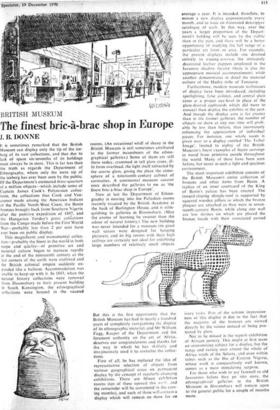BRITISH MUSEUM
The finest bric-à-brac shop in Europe
J. B. DONNE
It is sometimes remarked that the British Museum can display only the tip of the ice- berg of its vast collections, and that due to lack of space six-sevenths of its holdings must always be in store. This is far less than the truth as regards the Department of Ethnography, where only the mere tip of the iceberg has ever been seen by the public. Of the Department's estimated three-quarters of a million objects—which include some of Captain James Cook's Polynesian collec- tions, the collections that Cook and Van- couver made among the American Indians of the Pacific North-West Coast, the Benin bronzes brought back from Southern Nigeria after the punitive expedition of 1897, and the Hungarian Torday's great collections from the Congo made before the First World War—probably less than 2 per cent have ever been on public display.
This magnificent and monumental collec- tion—probably the finest in the world in both scope and qtiality—of primitive art and material culture began to increase rapidly at the end of the nineteenth century as the last corners of the earth were explored and the British colonial empire suddenly ex- panded like a balloon. Accommodation was unable to keep up with it. In 1883, when the natural history collections were removed from .Bloomsbury •to their present building in South Kensington, the ethnographical collections were housed in the vacated rooms. (An occasional whiff of decay in the British Museum is still sometimes attributed to the former incumbents of the ethno- graphical galleries.) Some of them are still there today, crammed in tall glass cases, ill- lit from overhead, the light itself refracted by the coarse glass, giving the place the atmo- sphere of a nineteenth-century cabinet of curiosities. A continental museum curator once described the galleries to me as 'the finest bric-à-brac shop in Europe'.
Now at last the Department of Ethno- graphy is moving into the Palladian rooms recently vacated by the British Academy at the back of Burlington House. and is relin- quishing its galleries in Bloomsbury. (May the aroma of learning be sweeter than the odour of natural history.) The new building was never intended for a museum (its great wall spaces were designed for hanging pictures), and its big rooms with their high ceilings are certainly not ideal for exhibiting large numbers of relatively small objects.
But this is the first opportunity that the British Museum has had in nearly a hundred years of completely reorganising the display of its ethnographic material, and Mr William Fagg, Keeper of the Department and the foremost authority on the art of Africa, deserves our congratulations and thanks for the way in which he has skilfully and imaginatively used it to revitalise the collec- tions.
First of all, he has replaced the idea of representative selection of objects from various geographical areas on permanent display by the concept of regularly changing exhibitions. There are fifteen exhibition rooms (ten of these opened this we?1c. and the remainder will be completed in the com- ing months), and each of these will contain a display which will remain on show for on average a year. It is intended, therefore, to mount a new display approximately every month, and to issue an illustrated descrip,ive catalogue of each. In this way, over the years a larger proportion of the Depart- ment's holding will be seen by the public than in the past, and there will be a better opportunity of studying the full range of a particular art form or area. For example, the present displays include one devoted entirely to wajang-poerwa, the intricately decorated leather puppets employed in the Javanese shadow theatre (there is also the appropriate musical accompaniment), while another demonstrates in detail the material culture of the Hadza tribe of Tanzania.
Furthermore, modern museum techniques of display have been introduced, including spotlighting, false ceilings, and central glass cases at a proper eye-level in place of the glass-doored cupboards which did more to conceal than display the exhibits in the past. And though the display area is far greater than in the former galleries, the number of objects on show at any one time will prob- ably be less than before, thus enormously enhancing the appreciation of individual pieces. For instance, one whole room is given over to a display entitled 'The Tribal Image', limited to eighty of the British Museum's finest examples of figure carvings in wood from primitive people throughout the world. Many of these have been seen before, but never in such a light and spacious environment.
The most important exhibition consists of the British Museum's entire collection of bronzes and other items from Benin. A replica of an inner courtyard of the King of Benin's palace has been erected. The inward-sloping shingle-roof is supported by squared wooden pillars to which the bronze plaques are attached as they were in seven- teenth-century Benin. while along one wall are low shrines on which are placed the bronze heads with their associated carved
ivory tusks. Part of the solemn impressive- ness of this display is due to the fact that the majority of the bronzes are viewed directly by the visitor instead of being pro- tected by glass.
Not to be missed is the superb exhibition of African pottery. This might at first seem an unpromising subject for a display, but the range and variety over almost the whole of Africa south of the Sahara, and even within tribes such as the Ibo of Eastern Nigeria, whose work is comparatively well known, comes as a most stimulating surprise.
For those who wish to say farewell to old favourites before they go into store, the ethnographical galleries in the British Museum in Bloomsbury will remain open to the general public for a couple of months
more.






































 Previous page
Previous page